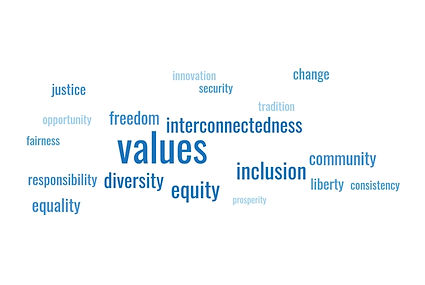1.5
The Role of Values in Collaborative Discussion
Submitted by Jack Byrd Jr.
This activity encourages participants to reflect upon and identify their personal values and to explore the role that values play in group discussions.
Learning Goals
Identify different kinds of values that are commonly embedded in a discussion.
Better understand how personal values can inform contributions in discussions.
Instructions
Set Up: Prepare for the Activity
Organize participants into small groups (5-6 ppl).
Begin by introducing the learning goals of this activity.
Step One: Craft Three Individual Value Statements (10 min)
Offer a few minutes for each participant to quietly craft their own value statements.
Share the following prompts:
What values are most important to you as a person? For example, maybe it is self-sufficiency, environmental sustainability, or justice. Write down your top values.
Take your top three values and craft value statements. For example, “I value personal responsibility. I believe that I, alone, am responsible for my actions.”
Step Two: Share Value Statements (10 min)
Within small groups, ask participants to share their value statements with at least one other person. Discussion partners can ask questions about value statements but they should not make comments or share judgments. For example, discussion partners might ask:
Where does this value come from? Was it taught to you or did you learn it some other way?
Can you share with me a time when you acted on this value?
Step Three: Practice Listening for Values in Discussions (30 min)
Craft a discussion prompt that is relevant for your group, or select one from the list of What IF… Scenarios.
In small groups, encourage participants to engage in honest discussion for about ten minutes. Allow enough time for everyone in the group to respond to the prompt.
Ask each group to pause the discussion and take a step back. Instruct participants to not worry about who was most convincing. Instead, as a group, ask them to identify which values informed their opinions. Prompts:
Which values informed the perspectives of people in your group?
How might someone else, not present in your group, respond to the prompt? What values would be informing their opinion?
Step Four: Debrief as a Full Group (10 min)
Discuss:
How does shifting the focus on values change the way you engage with others in discussion?
Which values seem most common and which seem to be outliers or less common? What does this tell us about our group?
TIME
60
min
MODULE
Introduction to Collaborative Discussion

This activity can be completed by any discussion group.

This activity can be used to build trust and interpersonal connection.

This activity can be used to support facilitation skills. See Sample Facilitation Certificate Program Design to illustrate sample sequencing.

This activity is suitable for professional or more formal learning environments.
Tell us what you think. Rate and review this activity:
Have any helpful suggestions or modifications for this activity?
Share them in the comments below!
0 Comments
YD
December 3, 2022 at 1:58:08 AM
Activity 4.8 provides useful phrases and techniques, as well as helps participants develop their own, to join in during discussions and express their views according to the goals they choose for themselves on what they want to offer to the discussion and how they want to be perceived.
YD
December 3, 2022 at 1:52:48 AM
Activity 4.7 uses a tactile and fun method, like a bag of beans, to have participants experience what it is like to have different amounts of power in a conversation. This activity also highlights how we base our ideas of how power is distributed on stereotypes.
YD
December 3, 2022 at 1:48:29 AM
Activity 4.6 employs useful tools like the Question Chart to help participants learn how to craft "good questions" that move beyond any assumptions they have about the views of others based on stereotypes or third party descriptions, and unearth their true views on the issue.
YD
December 3, 2022 at 1:45:08 AM
Activity 4.5 uses visual aids like the Emotion Wheel to push participants to move beyond just cognitive empathy and shows how to reflect back the emotions and understand their source through dialogue. It also helps participants differentiate between messages of intentional empathy and problem-solving.
YD
December 3, 2022 at 1:39:46 AM
Activity 4.4 uses both individual written reflection and discussion in small and large groups to explore the which aspects of a person's identity we use to determine if they should be included in the conversation on a particular issue. This activity also give participants to practice explaining and negotiating who is chosen.
YD
December 3, 2022 at 1:33:37 AM
Activity 4.3 uses physical movement and both lighthearted and serious topics to help participants see how positions on different topics lie on a continuum and how positions can change as one is exposed to new information or perspectives. Participants also flex their imaginative and creative muscle by arguing for the position opposite to theirs.
YD
December 3, 2022 at 1:28:28 AM
Activity 4.2 breaks down the individual aspects of active listening into separate rounds/steps to help participants consciously and methodically learn and practice this skill.
YD
December 3, 2022 at 1:25:28 AM
Activity 4.1digs deep into the many facets of social identity, by using drawing, as well as both written silent reflection and verbal discussion in small and large groups.
YD
November 29, 2022 at 6:26:51 AM
Activity 3.8 easily helps visualize the many dimensions of a topic by using the fishbone diagram.
YD
November 29, 2022 at 6:24:44 AM
Activity 3.7 provides useful mind tricks to help practice patience and giving people the benefit of the doubt, thus creating the sense of psychological safety required in collaborative efforts.
_edited.png)





